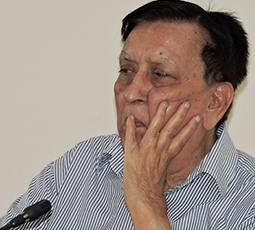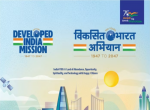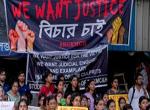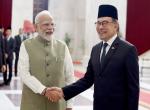Prevention of Communal and Targeted Violence (Access to Justice and Reparations) Bill, 2011 is an affront to the Indian civilization and tradition which since thousands of years believed in peaceful co- existence and respected the pluralistic values of life. The Hindu civilization demonstrated a spirit of harmony rather than conflict; of synthesis and tolerance rather than opposition. This ideal of harmony and tolerance of the Hindus has been carried on for thousands of years and even now the Hindus maintain impeccable faith in it. Only because of this civilisational value of peaceful co- existence, Christians, Parsis, Jews and Muslims were welcomed to India and they lived peacefully without a sign of conflict, until the Christians and Muslims themselves changed their behaviour conspicuously to expand their religious demography in India, in order to have political control over the nation. India has been home for all those living here under the aegis of secular Constitution, which even today guarantees absolute equality of faiths. Even today, theists and atheists have full liberty to observe their faith, even though both are diametrically opposite to one another. But the Communal Violence Bill, 2011 presents an entirely different picture when it presumes that the majority community (Hindus) are only killers and not the minority (Muslims- Christians). This Bill is a safeguard for only the minority and not for majority.
The entire Bill is spread over in IX chapters with 138 clauses, five schedules and three appendices. While its first chapter deals with definitions, The other chapters explain offences, prevention of communal and targeted violence, National Authority for communal harmony- Justice and reparation, procedures for investigation and trial- reparation and restitution and compensation, penalties, miscellaneous.
The most disturbing feature starts with chapter I itself in which under clause 3(e) ‘group’ means a religious or linguistic minority in any state in the union of India, or scheduled castes and scheduled tribes within the meaning of clauses 24 and 25 of Article 366 of the Constitution of India. Further clause 3(J) defines “victim’ means any person belonging to a group as defined under this Act, who has suffered physical, mental, psychological or monetary harm or harm to his or her property as a result of the commission of any offence under this Act and includes his or her relatives, legal guardian and heirs, where ever appropriate”. Therefore, in a situation where there is violence from two sides targeted at each other provisions and punishment of this Bill would be applicable only against one side.
The Bill presumes that killers are only majority and victims are only minority. Even in the case of sexual assault (clause- 7) it says that it can happen only to minority and not to majority. Similarly clause- 9 of the Bill completely exonerates minority from communal and targeted violence.
The Bill defines ‘hate propaganda’ in clause -8 in such a comprehensive manner that not only it completely curtails freedom of expression and fair comment but virtually anyone saying anything remotely criticizing a minority community or member of the community can be hauled by any complaint so long as he or she belongs to the ‘Group”. What is worse here that it is applicable against majority (Hindu) and not against Mullah openly inciting violence against those not included in the “Group”. Under clause 74 of the Bill if an offence of hate propaganda is alleged against a person it shall be presumed unless contrary is proved. Thus an allegation is equivalent to proof.
Even in the case of sexual assault (clause- 7), a person is said to commit sexual assault if he or she commits any of the following acts against a person belonging to a ‘group’ by virtue of that person’s membership of a ‘group’. It means sexual assault can be only against minority. Similarly clause 9 completely exonerate minority from communal targeted violence.
The clauses of the Bill have been drafted in a manner that if this Bill becomes law, only Hindus will be tried, convicted and sentenced of communal violence and incitement of communal hatred because the Constitution will refuse to accept that Muslims and Christians are capable of violence and hatred. If this Bill becomes law, any anonymous complaint can result into a police case against a Hindu for inciting communal hatred and the police will have to register it as a non-bailable offence. The accused who would be arrested would not even have the right to know who the complainant is. And the accused Hindu will virtually be presumed to be guilty unless he or she can prove his or her innocence. A Hindu activist who complains against fanatic Christian missionaries converting tribals through inducements and bribes will be sent behind bars; the Christian missionary or radical Muslim who openly call Hindu ‘heathens’ or ‘Kafirs’ and tramples upon idols of Hindu Gods or Goddesses will be forever found innocent by the Indian Constitution.
Attack on Federal Polity
The most dangerous aspect of the Bill is contained in clause – 20 wherein the central government is empowered to interfere in the affairs of state, in case of violence or attempted violence occurs. The clause 20 provides “the occurrence of organised communal and targeted violence shall constitute “internal disturbance” within the meaning of Article 355 of the Constitution of India and the central government may take such steps in accordance with the duties mentioned there under, as the nature and circumstances of the case so requires”. This is a cleaver design of the central government to usurp the Jurisdiction of the states which is squarely within its domain. The implication of the entire exercise is to curtail the role of the governor when the state government is intended to be destabilized. This clause is a direct attack on the federal polity of the country and an attempt to regress to back door centralism.
National Authority
Clauses 21 to 43 contained in chapter IV of the Bill deals with setting up of National Authority for communal harmony, justice and reparation, appointments of its chairperson, vice chairperson and other members, its functions, its powers, powers of investigations, enquiry, procedures with respect to armed forces, duty to respond to advisories or recommendations of National Authority etc. The sweeping power to the National Authority is so strong that the entire law enforcing machinery of the state would become pawn in its hand. The Bill provides for seven members for National Authority. Out of these seven members at least four of them including chairman and vice chairman shall belong to the ‘group’ (minority community). A Similar body would be formed in states. The National Authority shall have powers to (a) to enquire or investigate suo moto or upon any information or otherwise (b) observe, monitor and review the performance of duties by public servants (c) including postings transfer and replacement of any individual officer, administrative or police (d) control affected areas where outbreaks of communal and targeted violence or possibilities thereof, are reported or anticipated.
Clause 33(6) provides (a) every proceeding or investigation before National Authority shall be deemed to be a Judicial proceeding within the meaning of sections 193 and 228, and for the purposes of section 196 of the Indian penal code (b) the Authority shall be deemed to be a civil court for all the purposes of section 195 and chapter XXVI of the code of criminal procedure, 1973 (c) In course of investigation the National Authority may (I) summon any person (II) require discovery and production of any document (III) requisite any public record (IV) enter buildings (V) conduct raids and searches (VI) make recommendations to governments.
All 138 clauses of the Bill have been drafted in a manner which goes against the basic principle of the Constitution and Jurisprudence. It contradicts the basic principle of equality before law. If this Bill becomes Act then no one would be held responsible for Godhra incident in which all 59 ‘Karsevaks’ who were burnt alive were Hindus. How will this Bill deal with Shia- Sunni riot or in riot which takes place between two groups of tribals where both the groups belong to minority community; how will this Bill tackle the recent case in Kerala where one hand of a Christian professor was chopped off by a radical Muslim because both were minorities.
This Bill has completely ignored the fact that since the first riot occurred in the country in 1713 in Ahmadabad religious causes were mainly responsible for over 80 percent riots in the country. If we go through the causes of the riot, we will find roughly the following are its main causes: - playing music before mosques; throwing ‘gulal’ on Muslims or on the mosques; encroachment on places of worship; disputes over land belonging to places of worship; Hindu procession route by the side of mosques; provocative and abusive slogans against the other community; pelting stones or burning crackers to disturb the procession ; showing signs of insult to the religion or the symbols of religion; obstruction placed against the religious procession ; cow sacrifice by Muslims; Muslims injuring cows; on the issue of selling beef; desecration of idol, temple or mosque; business rivalry between Hindus and Muslims; rivalry between Hindus and Muslim musclemen, mafia, smugglers and criminals; quarrel between individuals or group of people of different communities; rape, kidnapping, abduction, molestation or outraging the modesty of a girl by a man of other community; marriage of a boy and girl of different communities; conversion; emotion; insecurity and rumours; news about riot in Pakistan or Bangladesh; provocative items in electronic and print media. The framers of the Bill have completely ignored the factual position and presumed majority community only responsible for the riots.
Prior to 2002, a serious communal riot had occurred in Ahmadabad in 1969 in which about 600 people were killed out of which 80% happened to be Muslims, property worth nearly five crores were looted or destroyed and over 30, 000 Muslims became refugees. Justice P. Jagmohan Reddy Commission for 1969 Gujarat riot had observed “The maintenance of Communal harmony is not entirely dependent on any one community alone but on both communities. Where communal atmosphere gets fouled and tensions are built up, in some way or the other both communities have to take the blame irrespective of the blame or culpability of any one community concerning the incident, which may have been the immediate cause of disturbances. It is only when both of them inspire confidence in each other that suspicion and distrust will be dispelled and feelings of brotherhood and amity will prevail”. (Commission’s report). But in the case of communal violence Bill, 2011 the draft committee members and Advisors which included persons like Asgar Ali Engineer, Sayed Shahbuddin and Teesta Setalvad unhesitatingly presumed that majority community is only responsible for riots.
While defining ‘Group’ SC/ ST has been purposely added to it to create an atmosphere of confusion and also to dissociate them from the fold of Hindu community. SC/ ST atrocities Act is already in existence and if there was any shortcoming, it could have been strengthened by some addition instead of including them in the Bill prepared for communal riots. The framers of the Bill very well knew that it would not be applicable in J & K because of Article 370 of the Constitution and it has no relevance in north- eastern states where hardly any Hindu- Muslim riots occur. Therefore, they have purposely drafted the Bill for rest of the country. But they have not mentioned anything for many such districts in many states where Hindus are in minority, like Kishanganj (Muslim 65%) in Bihar and many districts in Assam.
To sum up, the communal violence Bill 2011: -
- Recommends two sets of crPc for the ‘Group’ and others.
- It destroys the federal character of the Constitution.
- It is a tool to amend the constitution in shrewd and simple manner.
- It creates parallel authorities in the center and state.
- It makes the bureaucracy and police slave of the minority leadership.
- Onus of communal riots is thrown on the Hindus.
- Minorities are presented as permanent victims of Hindu majority, police force, bureaucracy and Judiciary.
- Minority veto is invented in the Bill.
- An authority created at the center was empowered to use Article 355 as a children’s toy.
- It assumes tyranny of the Hindu majoritarainism.
-------------------------------------------------
Published Date: 12th September, 2011










Post new comment